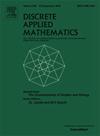Minimized compact automaton for clumps over degenerate patterns
IF 1
3区 数学
Q3 MATHEMATICS, APPLIED
引用次数: 0
Abstract
Clumps are sequences of overlapping occurrences of a given pattern that play a vital role in the study of distribution of pattern occurrences. These distributions are used for finding functional fragments in biological sequences. In this paper we present a minimized compacted automaton (Overlap walking automaton, OWA) recognizing all the possible clumps for degenerate patterns and its usage for computation of probabilities of sets of clumps. We also present Aho–Corasick like automaton, RMinPatAut, recognizing all the sequences ending with pattern occurrences. The states of RMinPatAut are equivalence classes on the prefixes of the pattern words. We use RMinPatAut as an auxiliary structure for OWA construction. For degenerate patterns, RMinPatAut is Nerode-minimal, i.e., minimal in classical sense. In this case RMinPatAut can be constructed in linear time on the number of its states (it is bounded by , where the length of pattern words). OWA can be constructed in linear time on the sum of its size and RMinPatAut size.
退化模式上团块的最小化紧致自动机
团块是给定模式的重叠出现序列,在模式出现分布的研究中起着至关重要的作用。这些分布用于寻找生物序列中的功能片段。本文提出了一种最小化紧致自动机(重叠行走自动机,OWA),用于识别退化模式中所有可能的团块,并将其用于计算团块集合的概率。我们还提出了类似Aho-Corasick的自动机RMinPatAut,它可以识别所有以模式出现结尾的序列。RMinPatAut的状态是模式词前缀上的等价类。我们使用RMinPatAut作为OWA构建的辅助结构。对于退化模式,RMinPatAut是最小化的,也就是经典意义上的最小化。在这种情况下,RMinPatAut可以根据其状态数在线性时间内构造(它以2m为界,其中m是模式词的长度)。OWA可以在其大小和RMinPatAut大小之和的线性时间内构建。
本文章由计算机程序翻译,如有差异,请以英文原文为准。
求助全文
约1分钟内获得全文
求助全文
来源期刊

Discrete Applied Mathematics
数学-应用数学
CiteScore
2.30
自引率
9.10%
发文量
422
审稿时长
4.5 months
期刊介绍:
The aim of Discrete Applied Mathematics is to bring together research papers in different areas of algorithmic and applicable discrete mathematics as well as applications of combinatorial mathematics to informatics and various areas of science and technology. Contributions presented to the journal can be research papers, short notes, surveys, and possibly research problems. The "Communications" section will be devoted to the fastest possible publication of recent research results that are checked and recommended for publication by a member of the Editorial Board. The journal will also publish a limited number of book announcements as well as proceedings of conferences. These proceedings will be fully refereed and adhere to the normal standards of the journal.
Potential authors are advised to view the journal and the open calls-for-papers of special issues before submitting their manuscripts. Only high-quality, original work that is within the scope of the journal or the targeted special issue will be considered.
 求助内容:
求助内容: 应助结果提醒方式:
应助结果提醒方式:


